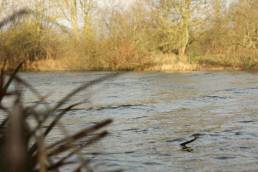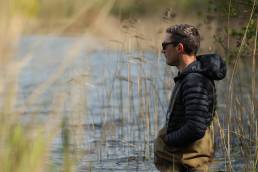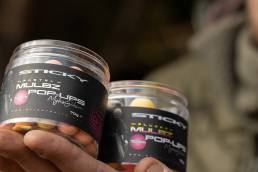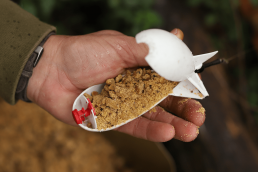
Adam Smith reveals his top tips for not only staying safe in the boat, but also his the edges that he has built up after a number of years experience.
I’ve been fishing on Stoneacre’s for the past few seasons now, which mainly involves a lot of boat fishing. Being able to use a boat is such an advantage, but can also be dangerous if you do not take proper care of yourself. Hopefully I can give you a few tips to keep safe and give you some insight into some nice little edges that I have picked up in the last few seasons.
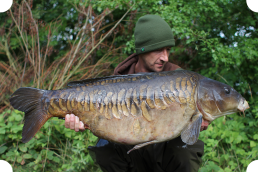
SAFETY TIPS

Firstly, and most importantly, you must wear a life jacket. There really is no excuse for not wearing one. Should you fall in and something happens, it will save your life. It is no bother wearing it and doesn’t hinder you in anyway, so please wear one. It is a mandatory rule on most lakes now that allow boats, so stick to the rules.
I would recommend getting yourself a decent life jacket too. Mine will only inflate once it has made impact with the water. Spray or rain will no set it off, which means it will only inflate if you are in an emergency. I also carry a spare rearming kit, should it inflate for any reason, you need a spare just in case.
A life jacket is an essential bit of kit and you should not step foot in a boat without one



One thing I had been guilty of in the past was wearing waders in the boat. After watching a friend nearly drown, I will never be doing it again. The water will fill them should you fall in and all that weight will drag both you and the jacket down. If you don’t want to get wet when you enter the boat, either put a pair of Crocs on or thigh waders can be good, providing that they are quite a lose fit.
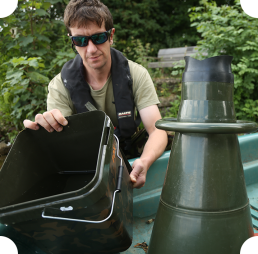

I use an motor on the back of my boat, which requires the use of a leisure battery. Anyone that has ever picked one of these up will know how heavy they are. It sits at the back of the boat, which is also where the seat is often placed and where you will need to be to steer the engine. To evenly distribute the weight, I either place my spare battery at the front, or alternatively a full bucket of water or bait. Its so important to even out the weight, otherwise the front end will tip and will cause you all sorts of problems.


I very rarely stand up in the boat too. I do from time to time now, but I have over 4-years experience using the boat. If you are not comfortable or experienced in boating, I would remain knelt down. You will find that it balances the boat better and you won’t feel off balance and risk tipping it.
A life jacket is an essential bit of kit and you should not step foot in a boat without one
TIPS & TRICKS


Firstly, if the water is fairly clear and not too deep, an aqua scope is a great tool to have. It will allow you to see right down to the bottom of the lake and search out for those little feeding spots. You can see what the carp have done to weed beds or natural spots, or even to areas that regularly see bait. There may be a large bit of weed that could affect the line lay going to the spot and you may want to take it out with the rake. There is a whole new world on the bottom of the lake and all those hours of sat there puzzling and making an idea in your head of what is going on out there, can be revealed in seconds.
It means that you can drop or lower the rig down on to the spot and bait it exactly how you would want it to be. With the scope, you are going to need some H-Blocks. These will keep an anchor on the spot, giving you a reference point for when the wind drifts you off away from the area. One thing that I do is when I am in the area that I want to fish; I lean over and look through the scope, while holding the block in my hand. Should I see something that I like the look of, I can drop it immediately, instead of scrambling around trying to find it and end up losing the spot.


I like to have a couple of big gripper leads on to make sure that it remains on the bottom and wont move. You want something that will keep that block in place, which is something that a smaller lead will struggle to do.
Once you have found your spot and are happy with it, then you can really think about fishing slightly different to what you are used to. Being able to use large leads is a great advantage and one that can be tricky to do if you are casting. I like using big leads, mainly for holding the bottom firmly and also, for hooking wary carp.
Attach a couple of big leads to the block, just to make sure it keeps it in place


I also use the N-Trap soft hook link, which is fairly supple. This sort of arrangement may be prone to tangling when casting, but when using a boat you don’t have to worry about that. Think about fishing in the margins and using the best technology that you can muster together. It is exactly the same when using a boat, you can place anything you like down there and not worry about tangles.
Baiting is another edge and the way you can do it. Just because you are in a boat and it is easy to bait up, go trigger-happy and fill it in because you can.
If the lake is fishing slow, fish over a handful of boilie crumb or some chops and simply fish for a bite.


I love using boilie crumb, but when spodding it, it can end up spread across the swim. By keeping it tightly baited, those fish won’t be spending hours searching out all the little bits of food. They will have to butt heads to find it and that is when they will competitively feed, thus giving you a better chance of a bite.
The use of liquids is also another good one, with products such as the Pure Krill liquid going straight to the bottom. I like having a lot of smell in the swim and the addition of this particular product can really help boost your catch rate.
I like to glug all of my crumb and boilies in it until it really soaks it all up. Then, when trickling it in by the block, you can watch it all go down to the bottom, releasing so much attraction and food signals.

